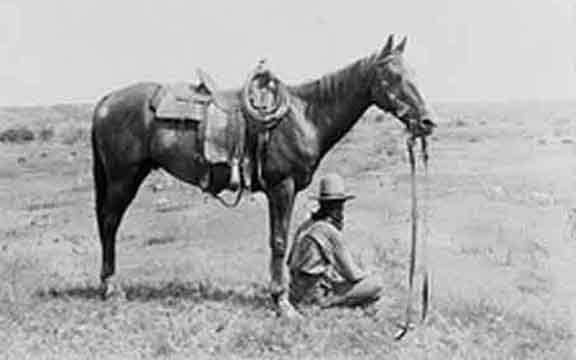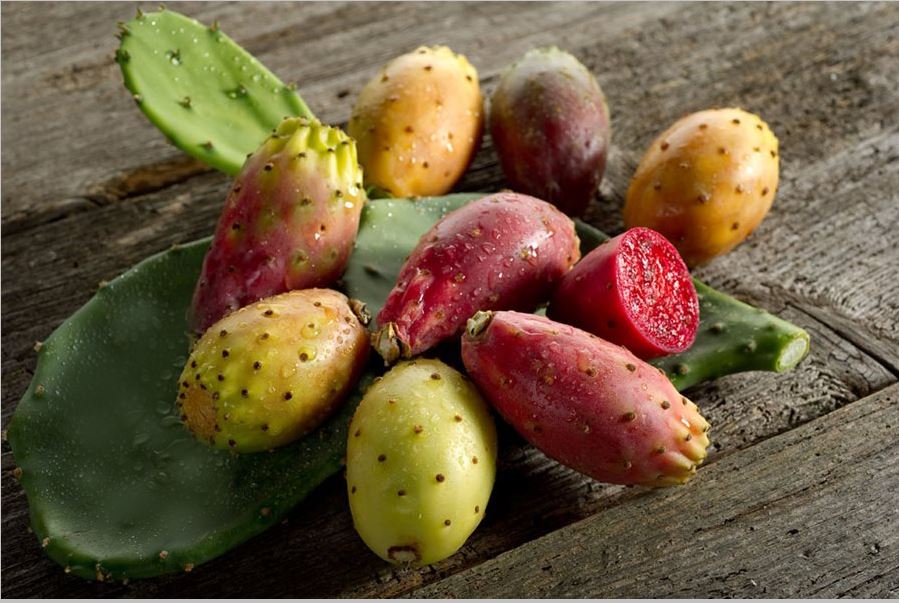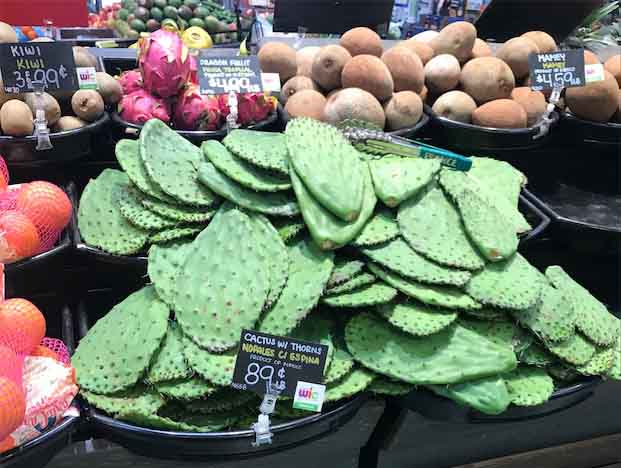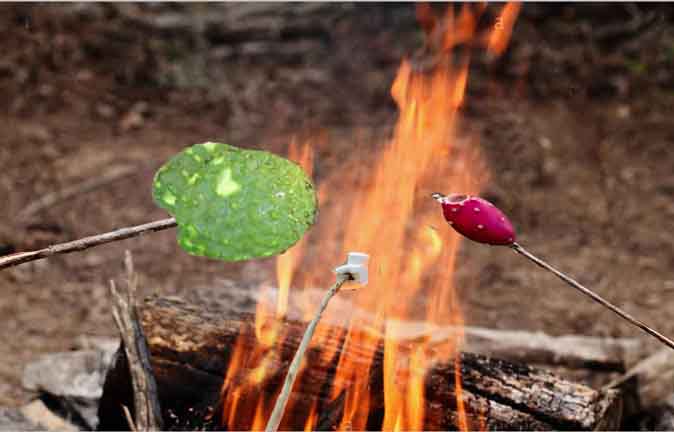How to Cook Cactus Paddles | Como Cocinar NopalesIn tales about the West, the cactus is sometimes portrayed as a water-bearing plant that saves In tales about the West, the cactus is sometimes portrayed as a water-bearing plant that saves thirsting cowpokes lost in the desert.  lost in the open range. The Barrel Cactus fruit can be picked and eaten raw and has no spines, making it the easiest to handle. The flowers and buds are also edible. One of the legends of the American Wild West was that Barrel Cacti could be cut open and the pulp squeezed for water that would keep you alive in the deep desert. But any hungry range rider worth his spurs would know that some types can provide right good eating, too, especially those known as Indian figs, nopales, prickly pears, or beaver tail cacti. In fact, there are dozens of varieties of these hardy forageables. They're members of the genus Opuntia, which encompasses well over 200 species. These can be divided into two broad groups:
Apparently, all the fruits of a true cactus are safe to eat. However, many need special preparation or even need to be cooked.
 More info on Tunas ==> HERE <==. The flavors range from fruity and sweet,to bland into the range of "choke a starving goat" bitter. Native inhabitants of cactus ranges had to figure out which were edible plants and which were best left alone. Many people are surprised to learn that some kinds of prickly pear cactus can be found as far east in this country as Massachusetts. For the really good eating types, you have to go to the Southwest, where the spiny plants can be seen growing wild along highways and on the open range. In some areas, in fact, they've become so numerous that they're considered a pest weed by ranchers and farmers. In Mexico, though, the cacti are raised commercially, and the fruit (called tuna) and the edible pads (nopales) are marketed. If you don't have access to wild cactus and can't grow it in a backyard patch, you can find nopales in the Mexican foods section of your supermarket.  nopales without the snakes. If you are adventurous, you will want to know what to do with cactus! Cactus pads are used in Mexican and Latin American cooking, but only pads from one kind of cactus: the Prickly Pear Cactus. The same one that produces the Prickly Pear fruit. The flat green paddles are eaten like a vegetable. When cooked they have a taste comparable to green beans and a texture similar to okra. Others say they have a nice lemony flavor and a light crunch like bell peppers. Small, young pads harvested in early spring are thought to be the most succulent, delicate in flavor, and have the fewest spines. The thicker a pad, the older it is. Choose firm, tender pads that are about 1/4-inch thick. Avoid soft, cracked or wilted pads since this means they are old.
The cactus pads will range in color from pale to a dark green. They are usually sold with the thorns removed. The pads are often sold whole or cut up in strips or cubes and bagged for convenience. Cactus pads are also available canned. Fresh cactus pads are best used in a few days. Edible cactus can be refrigerated for more than a week if wrapped tightly in plastic.
Do Not FearIntimidating looking, perhaps, but quite easy to prepare and cook. Most fresh cactus pads in the store will have the spines removed. If they don't, however, here is how to prepare them.  take your time Using tongs or thick gloves, wash the pad. Holding the pad at the thick end with the tongs, cut off the thorns using a sharp knife at an angle, pushing the knife away from you in a scraping motion. Make sure to remove each "eye" of each thorn. You may need to cut these out. Go over them to double check all spines are removed. There are also small, hard to see spines called glochids. Rinse the pad again to wash away any debris. Trim off the outer quarter-inch edge of the pad and the thick base, and discard. Peel or cut off any discolorations or bruises.
Another method of preparing the pads is to burn off the spines and glochids with a blow-torch or over a flame using the tongs. The pads are now ready to cook. Cooking CactusDepending on how you are using this vegetable will determine whether you leave the pads whole, cut in strips, or cube it. Edible cactus can be eaten raw or cooked. They can be simmered, boiled, sauteed, deep fried, or grilled. syrup or ketchup? Hey, that Strawberry Red Cactus Jam looks good. Get some ==> HERE <== They are best served with a tender crunchy texture. Over-cooked pads will have a slimy texture. Combine them with different ingredients in a variety of healthy nutritious dishes. Here are a few suggestions: Boiling - When boiling the pads, you may have to change the water and re-boil them. The sap that comes from the pad may be thick. As a guide, the thicker the pad, the thicker the sap. The pads are then drained off and rinsed in cold water. Why not make up an authentic Mexican salad using chopped onions, cilantros, jalapenos peppers, diced tomatoes, and a squeeze of lime juice, salt, and pepper? Grilling - If grilling the pads, season well with salt and pepper. The pads are ready when they are slightly brown in color and tender to the touch. They could also be seasoned with a little olive oil, squeeze of lime juice, and a dash of salt.  having a good time Raw or cooked cactus pads may be added into many dishes to make unique healthy dishes. They can be diced and used as a topping on yogurt or cereal or blended into a smoothie. Why not try mixing them into eggs, casseroles and stews. They are a tasty addition to salsa and quesadillas. A hearty vegetable soup is a good option, as is a vegetable or fruit salad, or even just eat them alone. The choice is yours with this versatile, nutritious vegetable! You can also cook it into a jelly. Alternatively, you can pickle cactus pads and use it as a condiment with other dishes.
Cactus pads have a flavor affinity for cheese, chiles, cilantro, corn, eggs, lemon, lime, onions, oregano, salsa, scallions, sweet bell peppers, tomato, tortillas, and tropical fruits. Nutritional BenefitsOne cup of raw cactus pads only contains:
One cup also provides 20 percent of the Daily Value for manganese, 14 percent of the Daily Value for calcium, 13 percent of the Daily Value for vitamin C, and 11 percent of the Daily Value for magnesium. Benefit of getting em at Walmart - no snakes! Watch more than your fingers, if you pick tunas in a field! |